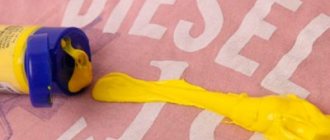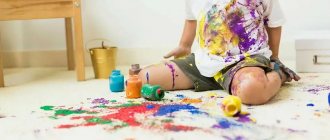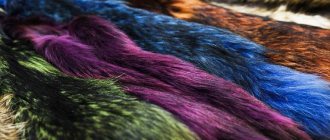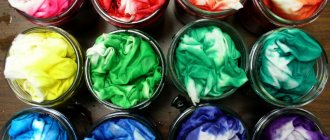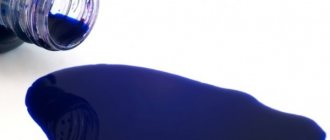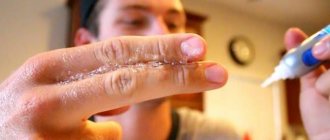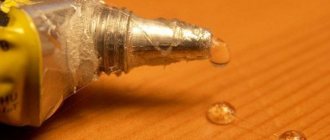Water-based paint is, without a doubt, the leader in sales among paints and varnishes. And, of course, every person should know how to wipe off water-based paint. When painting walls or ceilings, the paint will definitely get on clothes, furniture, and floors.
Clothes and hands are the first things to start with. Fresh stains on clothing should be removed using a simple principle: from edge to center. By following the basic steps, the stains will quickly disappear.
Important ! Make sure before cleaning and try the product on the edge of your clothes so as not to completely ruin the item. It is equally important to check your own reaction on your hand to avoid harmful allergic consequences.
Fresh water-based paint can be easily removed using plain water. Once the stains have dried, it will take some effort. You can use pure gasoline, thinner, alcohol, kerosene. You need to apply the product onto a cotton swab. For example, alcohol can easily remove old paint.
You can also remove water-based paint from clothes by soaking it in a special solution. You will need: vinegar, warm water and salt. Mix all ingredients in proportions 2*2*2. Pour onto the soiled item of clothing and leave for two hours. Afterwards, you can wash it.
When standard methods for removing stains from things do not help, you should turn to specialists and use dry cleaning services.
What should you do first?
It is much easier to remove paint from any clothing if it is fresh. What measures need to be taken immediately:
remove as much paint as possible from the fabric with a scraper or damp cloth; Turn the item inside out and carry out any manipulations only from the wrong side. prepare a work surface, cover it with oilcloth or old newspapers.
Advice! Stains must be processed from the edges to the center so as not to smudge them.
It is not recommended to try to remove paint from fabric on painted or varnished surfaces, so as not to damage the outer layer of the coating. Also, do not do this on parquet or laminate.
Lifehacks
When water-based paint hits clothing, it quickly absorbs into the fibers of the fabric and leaves bright marks. What to do in this case? How to remove water-based paint from clothes? It is not at all necessary to purchase special products to get rid of such stains. There are simple folk methods with which you can remove stains from water-based paint.
From this article you will learn how to remove water-based paint from clothes.
Enamel and oil paint
You can remove oil paint or enamel if you first wipe it with vegetable oil. Sunflower, olive or any cosmetic oil will do. After treatment, the item must be washed with liquid dish soap and then with powder. It is guaranteed to remove any remaining fat.
Second method: take 72% laundry soap and alcohol, ethyl or technical. First, things need to be washed in water at 38-40 ° C with soap and soaked for 30 minutes. Wipe off any remaining traces with alcohol.
Advice! It is quite easy to remove paint from a Bolognese jacket with white alcohol; kerosene will also work.
Several ways to scrub off enamel:
- Apply gasoline, then go through an ammonia solution, wash the item with powder and rinse thoroughly.
- Prepare a mixture of gasoline and acetone in equal proportions and, moistening a cotton swab with it, wipe off the stain.
- If the enamel has already dried, you need to prepare the following remedy: combine turpentine, gasoline and alcohol. Distribute over stains and leave for 30 minutes. When the enamel softens, scrape it off with a knife and use the same mixture to wipe away any remaining marks.
If there are faint stains on clothes, a soda solution will remove them. For 200 ml of water you need to take 2 tbsp. l. soda Soak the desired area in the prepared product for several hours.
Recommendations
To remove water-based emulsion, it is recommended to use the following tips:
- If it is necessary to remove old paint from a large area (walls, ceiling), all objects in the room should first be covered with film.
- Repair work should be carried out using personal protective equipment - respirator, gloves, goggles.
Fresh splashes and stains of water-based paint must be removed immediately and washed with water.- Preliminary moistening of the surface with a water-based coating must be carried out in small areas, acting gradually.
- When doing repair work, you should not layer water emulsion of one color on top of another color.
- It is advisable to carry out construction and repair work in the warm season, when the air temperature does not drop below +18°C.
- Cheap safety glasses, which are necessary especially when removing paint from the ceiling, are significantly inferior in quality and convenience to expensive models. One of their disadvantages is poor visibility, which affects the speed and accuracy of work.
Water-based paint
You can wash the water emulsion with hot water and tar or laundry soap. The dirt will come off without any problems.
What to do if the water emulsion has dried out:
- wipe it off with a disk moistened with ammonia;
- Clean natural fabrics with undiluted gasoline;
- Clean synthetic items with vegetable oil.
Advice! There will be no greasy stains on your clothes if you wash them with dishwashing gel.
An effective recipe for removing water-based paint: combine 50 ml of 9% table vinegar, 40 ml of ammonia and 10 g of table salt. Rub the stain with this mixture, spread it in a thick layer and leave for 20 minutes. Then wash by hand with bleach powder.
Traditional methods of dealing with old stains
It is not always possible to immediately remove water-based emulsion stains from floor coverings and walls. When they dry out, you have to scrub them with various means. First you should try rinsing with water or soapy water. Only then do they begin to use aggressive liquids.
Alcohol
The water emulsion remaining on the suspended ceiling after repairs spoils the appearance of the room. And here alcohol, which is applied to the stains, will help. It is best to dilute alcohol with water in a 1:1 ratio and rinse the stains. To avoid streaks, you need to wipe it dry with a soft cloth.
Read also: Taxcom. Business software (@TaxcomRu)
Ammonia
Linoleum spoiled by colorful spots after repair, the laminate is scrubbed with a solution of ammonia. Efforts must be made to clean surfaces from contamination.
Vinegar
Plain paint can be easily cleaned with table vinegar. Dilute it with water and wipe with a soft brush over plastic and tile surfaces. Helps eliminate contamination and surface wetting with acid solution. It is worth holding for a few minutes so that the paint comes off. It is also easy to remove stains from glass with vinegar.
Acrylic or latex paint
You can remove acrylic paint from things in this order:
- Wash the fresh stain with water at a temperature of 30-35C. Wring out the item and turn it inside out.
- Rub powder or liquid detergent into the stain from the inside out and leave to act for 1 hour.
- Wash the treated clothing in a machine at a high temperature allowed for this type of fabric.
An additional way to remove acrylic paint from delicate fabrics: rub the stain with 72% laundry soap. After 20 minutes, treat with industrial alcohol. After this, the clothes can be washed in warm water.
Alcohol will help remove latex paint from clothes. It is applied to stains undiluted. It is important to note that brightly colored items may fade a little. Another option: moisten the marks with alcohol and cover with fine table salt for 30-40 minutes.
Dried latex paint can be removed mechanically. For this you need tape. A piece of adhesive tape is pressed tightly onto the contaminated areas and sharply torn off. After such a procedure, sticky traces may remain, but they can be easily removed with regular washing with powder.
Features of removal from various types of surfaces
When choosing a coating removal method, the following points must be taken into account:
- surface material;
- vertical/horizontal plane arrangement;
- freshness of the coating;
- layer of paint.
How to remove it from the floor?
A wooden floor can be cleaned of water-based emulsion with a spatula or a brush with metal bristles. The disadvantage of this method is the high labor intensity of the dye removal process .
Chemical paint strippers work faster, but not all of them are designed for use on wood. To avoid getting into trouble, be sure to read the instructions for the drug.
These products are used undiluted. Apply solvent to a rag and wipe the stain. After the paint has been washed off, the area is washed with water and wiped dry.
Parquet can be cleaned using one of the following products:
- table vinegar;
- acetone;
- methyl alcohol.
Tiled floors are very easy to clean. This coating allows the use of chemicals and intense rubbing with a rag.
If the floor is concrete, then a hair dryer will allow you to remove the coating faster . Exposure to high temperature changes the structure of the paint, leading to its softening, and such a substance can already be easily removed with a spatula. This process is also not quick. An alternative solution to the problem is shot blasting equipment.
The use of a special tool allows you to remove even old multi-layer coatings of water-based paint. The disadvantage of this application is the high cost of special equipment. You can minimize costs by renting an expensive car.
What to clean from the ceiling?
A ceiling made of plasterboard and painted with water-based emulsion is best cleaned with a chemical solvent. It is applied for 20 minutes, after which the softened paint is cleaned off.
Even with the most careful actions performed, it is recommended to complete the process by grinding the surface .
The peculiarity of drywall is the presence of cardboard, which is sensitive to intense impact, as a result of which it can even be damaged.
How to remove from linoleum?
Fresh stains of water-based paint on laminate or linoleum can be removed very well. It is enough to wipe with a wet cloth or use a soap solution .
It will take more time to remove dried blots - the stains will have to be soaked and only then washed.
Solvents and mechanical methods using abrasive tools are not suitable for linoleum, as they can damage the material.
How to remove from plastic?
Like other surfaces, plastic can suffer from careless handling of paint. Stains can be removed from plastic frames with white alcohol or ammonia solution . It is better to remove paint from glass with a special scraper.
To remove paint from plastic, it is possible to use liquid glass or sealant, which, when dry, destroys the texture of the paint, making it easy to remove.
You can pry off the frozen layer, using extreme caution, with a sharp knife.
Another acceptable method is to heat the surface to 60-70°C, if the composition of the plastic allows it , and clean it off when the paint begins to peel off. Raising the temperature above the permissible level is not recommended, as this increases the likelihood of damage to the plastic itself.
How to wash clothes?
If drops of paint just get on clothes, they can be removed with paper and washed with water. For large stains that were not noticed immediately, it is recommended to pre-soak the clothes using washing powder for half an hour, and then wash them as usual.
How to clean delicate surfaces?
The peculiarity of cleaning delicate surfaces is the impossibility of using intense chemical, thermal or mechanical influence . As a result, washing can only be done using warm water and a cloth.
The process of removing paint from delicate surfaces usually takes a long time.
Watercolor and gouache
Washing watercolor paint and gouache is quite simple, since these substances are easily soluble in water. If paint gets on clothes, the stains must be lathered up and then placed in the washing machine. It is important to begin removing traces immediately.
Advice! The water temperature should not be higher than 30 °C, otherwise the particles will penetrate deep into the tissue structure and will be much more difficult to remove.
If the stains have been there for a long time, the following methods will help to remove them:
- rub problem areas with laundry soap, machine wash at 60-70C;
- generously rub the marks with 9% table vinegar, rinse after 30 minutes;
- soak the textiles for 1 hour in 40C water with the addition of dishwashing detergent.
Bleach works well to remove stains from watercolors and gouache. When working with children's clothing, it is necessary to take into account that products containing chlorine can cause irritation to the child's skin. It is better to use oxygen, optical brighteners.
Cleaning a stretch ceiling
Removing water-based emulsion stains from a stretch ceiling is carried out only with a soap solution. To do this, it is not necessary to use solid soap, because both liquid and washing powder are suitable. But, in order to avoid an unknown chemical reaction, it is better not to combine several detergents.
Soak a cloth or dishwashing sponge in the prepared solution, then simply scrub the surface of the ceiling with gentle, slow movements. This cleaning method can also be used if the stretch ceiling structure is made of fabric.
Printer ink
When replacing a cartridge, toner particles often stain your clothes and hands. Fresh paint can be washed off with cold water and toilet soap. Contaminated areas must be washed immediately so that most of the dye does not have time to be absorbed into the fabric.
You can remove old traces of paint like this:
- Lubricate the stain with laundry soap and soak in warm water for 2 hours. Then rinse the clothes, wipe off the marks with ammonia;
- 1 tbsp. l. dilute potato starch with water to a paste consistency, apply for 2 hours, then wash the item in hot water with washing powder;
- wipe off dirt with glycerin, then soak in a solution of ammonia, in a proportion of 50 ml per 0.5 liter of water. The final stage is washing with laundry soap;
- Toner can be removed from cotton and denim fabrics using gasoline or kerosene. During the procedure, the windows in the room should be kept open;
- if a piece of clothing is slightly stained, you can soak it overnight in cold milk or 3% peroxide.
Bleach will help get rid of ink stains. Products containing chlorine are not suitable for treating colored fabrics.
How to remove water-based emulsion from different types of fabric
Depending on the composition and structure of the material, special means are used to remove traces of color.
- You can wipe off dirt on silk or chintz using purified gasoline. Place a white cotton cloth under the stain and a layer of blotting paper on top. Moisten a cotton sponge with the liquid and wipe the problem area with it, moving from the edges to the center. When the dirt has completely disappeared, treat the area where the paint was with paper, wash the item well in warm water with powder or soap, and then dry in the fresh air.
- White spirit will help get rid of stains on thick denim or tarpaulin. Rub the problem area with a sponge soaked in solvent, then wash the item and air dry.
- When cleaning synthetics, you should not use either gasoline or solvent, as they will destroy the fibers of the fabric. Vegetable oil will come to the rescue. You need to place a white cloth and a piece of cellophane under the stain so that the fat does not spread to other places, and rub the stain with a sponge generously moistened with oil. It may take a long time for the color marks to disappear. Finally, all that remains is to get rid of the greasy stain, which a degreaser dishwashing detergent will help remove. Some people use a cotton swab soaked in a soap solution.
Please note that old stains that have dried on the product may initially require mechanical removal using a knife or scraper. Do not use such tools on thin fabrics that are easily damaged.
Stamp ink
How to wash off the paint used for seals and stamps is a problem that is relevant for office employees. A few simple ways:
- Dilute 20 g of mustard powder with cool water to make a paste. Apply it to the stained area and leave for 8-9 hours. Gently scrape off the dried mustard. Wash off any remaining traces with toilet soap. This method is good for synthetic fabrics;
- wipe off traces of paint with the mixture: 2 tbsp. l. ammonia and 2 tbsp. l. turpentine. Wash in cool water with powder;
- mix 1 tbsp. l. technical alcohol and 1 tbsp. l. liquid glycerin. Apply to stain and rub. The recipe is suitable for clothes made of genuine leather or leatherette. It is allowed to use ethyl alcohol instead of technical alcohol;
- A method suitable for white clothes is to treat the marks with fresh lemon juice. You need to carry out the procedure twice, and then boil the item for 2-3 minutes. Citrus juice can be replaced with a solution of citric acid: 1 tbsp. l. powder per 100 ml of water.
Advice! Fresh stamp ink can be easily wiped off with wet wipes. And they are washed off from the skin of the hands with hot water and soap. They can also be removed with acetone or nail polish remover.
How to get rid of old stains?
Here are a few tricks on how to remove stubborn paint stains that have long dried out:
- If the paint is in a thick, dense layer, you can remove it mechanically: pry the edge with the tip of a knife and crumble it. It is necessary to act carefully, without violating the integrity of the tissue;
- A product suitable for white items is chlorine. The stain is generously filled with “Whiteness” and left for 1 hour. Then you can wipe it off with a cotton swab. An alternative option is boiling. For 5 liters of water you need to add 150 ml of chlorine bleach, and boil the item in this solution for half an hour. Wash off residual traces with laundry soap;
- You can remove dried paint from calico, satin, and chintz in light colors with 3% hydrogen peroxide. Pour the solution over the traces and leave for 1.5-2 hours. Repeat the procedure twice or three times, remove any remaining paint with acetone;
- synthetic fabric, natural wool and silk are treated with turpentine. Apply 50 ml of liquid to the dried stain and wipe it off.
In order not to spoil good things, you should prepare for painting work: change into old unnecessary clothes and protect your hands with gloves.

